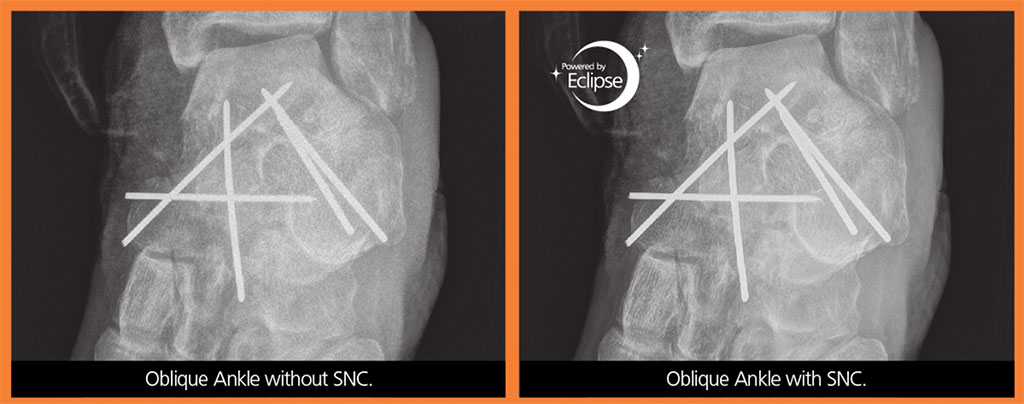Noise Cancellation Technology Improves X-ray Image Quality
By MedImaging International staff writers
Posted on 26 May 2021
Artificial intelligence (AI)-based technology can reduce image noise by two to four times in flat image areas.Posted on 26 May 2021
Carestream (Rochester, NY, USA) Smart Noise Cancellation (SNC) software is designed to perform digital enhancement of an X-ray radiographic image processed within the company’s Eclipse-powered ImageView software. The optional feature supports all Carestream DRX computed radiography (CR) and direct radiography (DR) detectors. The SNC module itself consists of a convolutional neural network (CNN) trained on clinical images with added simulated noise to represent reduced signal-to-noise (SNR) acquisitions.

Image: The same image with and without SNC (Photo courtesy of Carestream)
The Smart Noise Cancellation operation passes the acquired preprocessed image through the trained CNN based on a U-Net architecture to generate a 2D map of the estimated noise found in the image (the Noise Field) that removes grid frequencies and direct exposure and collimator blades. The enhanced image contains the same image quality attributes (brightness, latitude, and overall contrast), preserves high-frequency sharpness, and improves contrast detail. The images also show no substantial residual edge information within the regions of interest.
Objective testing demonstrated that SNC processing enables a 2x–4x noise reduction in flat image areas, preserves high frequency sharpness, and improves contrast detail. Additionally, a blind clinical reader study using board-certified radiologists found that 89.5% of all study ratings showed a slight to strong preference for SNC-processed images. In addition, 64% of the diagnostic quality ratings improved--based on the RadLex rating scale--and 56% of these ratings improved from “limited” or “diagnostic” to “exemplary.”
“Carestream is a leader in using AI for noise cancellation with X-ray images. Our team of imaging scientists has been able to separate image noise from sharpness and contrast using AI-based algorithms that result in remarkable image quality,” said Jill Hamman, worldwide marketing manager of Global X-ray solutions at Carestream. “This technology provides improved anatomical clarity, preservation of fine detail and better contrast-to-noise ratio for images acquired at a broad range of exposures, which can help improve diagnostic confidence and alleviate physician fatigue.”
Noise is often an undesirable by-product of image capture, and can often obscure critical anatomical data. However, traditional noise reduction introduces blurring, which degrades image sharpness and might remove important anatomical information. Conversely, the more an image is sharpened, the more noise may be enhanced.














